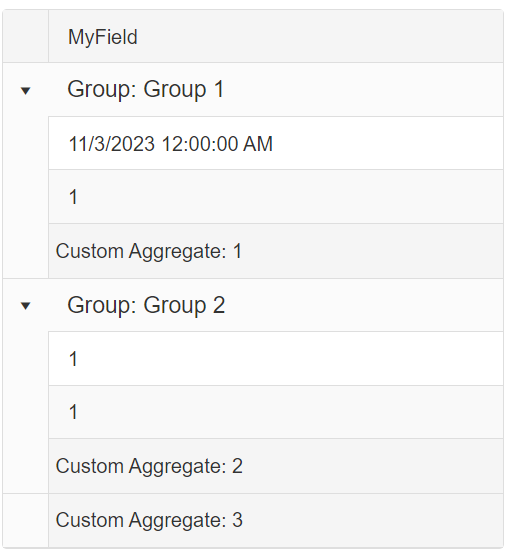New to Telerik UI for ASP.NET AJAX? Start a free 30-day trial
Exclude certain rows from Column Aggregate
Updated over 6 months ago
Description
Sometimes one might want to exclude specific rows from being aggregated.

This will require using custom aggregation.
Solution
- Set the
Aggregateproperty of the Column to Custom. - Bind the
OnCustomAggregateevent to the Grid. - In the event handler, you can calculate the values you want and update the footer accordingly
Example
ASPX
<telerik:RadGrid
ID="RadGrid1"
runat="server"
AllowPaging="True"
Width="800px"
OnNeedDataSource="RadGrid1_NeedDataSource"
OnCustomAggregate="RadGrid1_CustomAggregate"
MasterTableView-ShowGroupFooter="true"
ShowGroupPanel="true"
ShowFooter="true">
<ClientSettings AllowDragToGroup="true">
</ClientSettings>
<GroupingSettings ShowUnGroupButton="true" />
<MasterTableView AutoGenerateColumns="false">
<GroupByExpressions>
<telerik:GridGroupByExpression>
<GroupByFields>
<telerik:GridGroupByField FieldName="Group" />
</GroupByFields>
<SelectFields>
<telerik:GridGroupByField FieldName="Group" />
</SelectFields>
</telerik:GridGroupByExpression>
</GroupByExpressions>
<Columns>
<telerik:GridBoundColumn DataField="MyField" HeaderText="MyField" DataType="System.String" Aggregate="Custom" />
<telerik:GridBoundColumn DataField="Group" HeaderText="Group" />
</Columns>
</MasterTableView>
</telerik:RadGrid>C#
private DataTable OrdersTable()
{
DataTable dt = new DataTable();
dt.Columns.Add(new DataColumn("MyField", typeof(string)));
dt.Columns.Add(new DataColumn("Group", typeof(string)));
for (int i = 0; i < 10; i++)
{
int index = i + 1;
DataRow row = dt.NewRow();
row["Group"] = index % 2 == 0 ? "Group 1" : "Group 2";
if (index == 2)
{
row["MyField"] = DateTime.Now.Date.ToString();
}
else
{
row["MyField"] = 1;
}
dt.Rows.Add(row);
}
return dt;
}
protected void RadGrid1_NeedDataSource(object sender, GridNeedDataSourceEventArgs e)
{
RadGrid grid = sender as RadGrid;
DataTable sourceData = OrdersTable();
grid.DataSource = sourceData;
}
protected void RadGrid1_CustomAggregate(object sender, GridCustomAggregateEventArgs e)
{
if (e.Column.UniqueName == "MyField")
{
if (e.Item is GridGroupFooterItem) // Custom Aggregate for the items within the Group
{
GridGroupFooterItem groupFooterItem = (GridGroupFooterItem)e.Item;
GridGroupHeaderItem groupHeaderItem = groupFooterItem.GroupHeaderItem;
GridItem[] groupChildItems = groupHeaderItem.GetChildItems();
decimal counter = 0;
for (int i = 0; i < groupChildItems.Length; i++)
{
GridDataItem dataItem = groupChildItems[i] as GridDataItem;
if (dataItem != null)
{
decimal numericValue = 0;
if (decimal.TryParse(DataBinder.Eval(dataItem.DataItem, "MyField").ToString(), out numericValue))
{
counter += numericValue;
}
}
}
e.Result = counter;
}
else if (e.Item is GridFooterItem) // Custom Aggregate for all items in the Grid
{
double sum = 0;
DataTable dt = RadGrid1.DataSource as DataTable;
foreach (DataRow row in dt.Rows)
{
double numericValue;
if (double.TryParse(row["MyField"].ToString(), out numericValue))
{
sum += numericValue;
}
}
e.Result = sum;
}
}
}